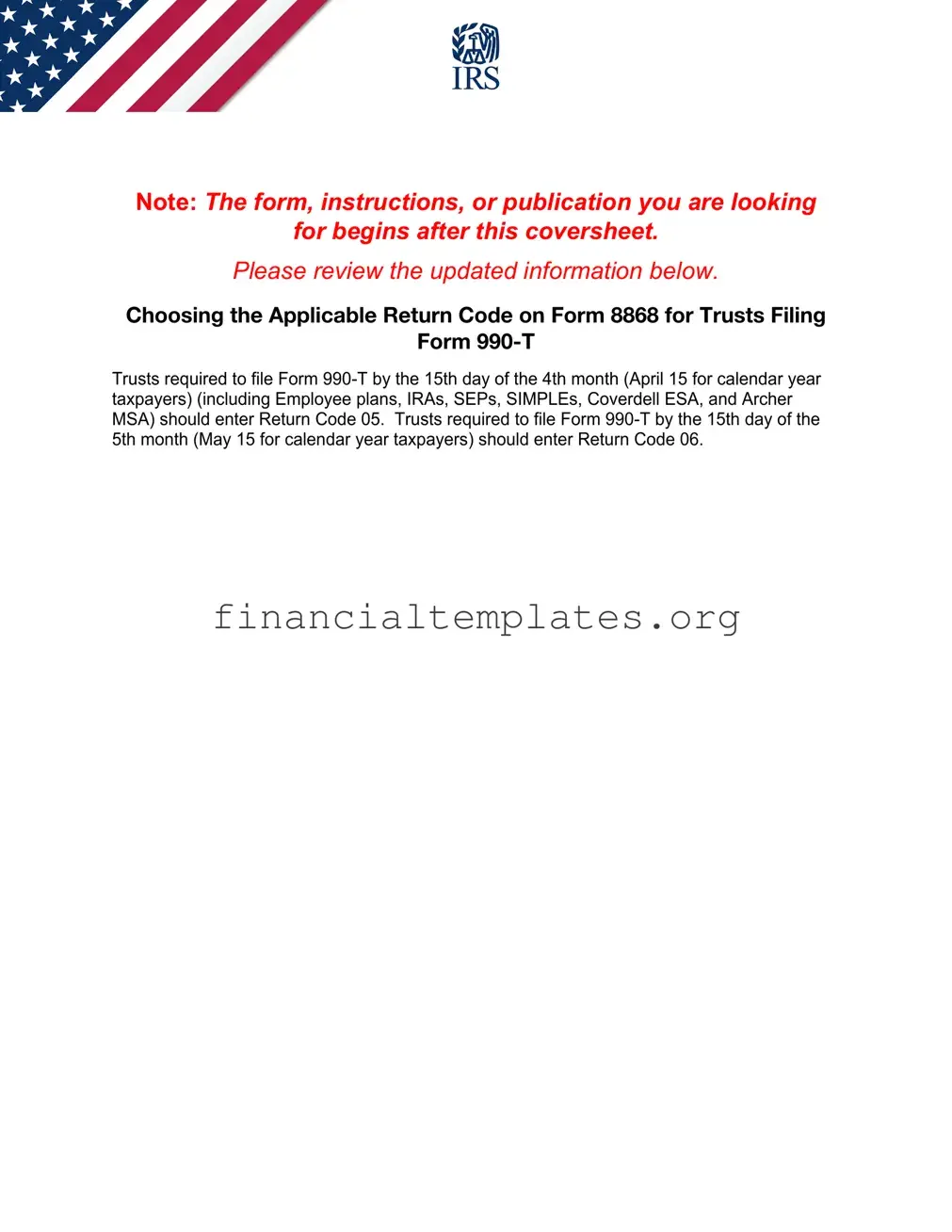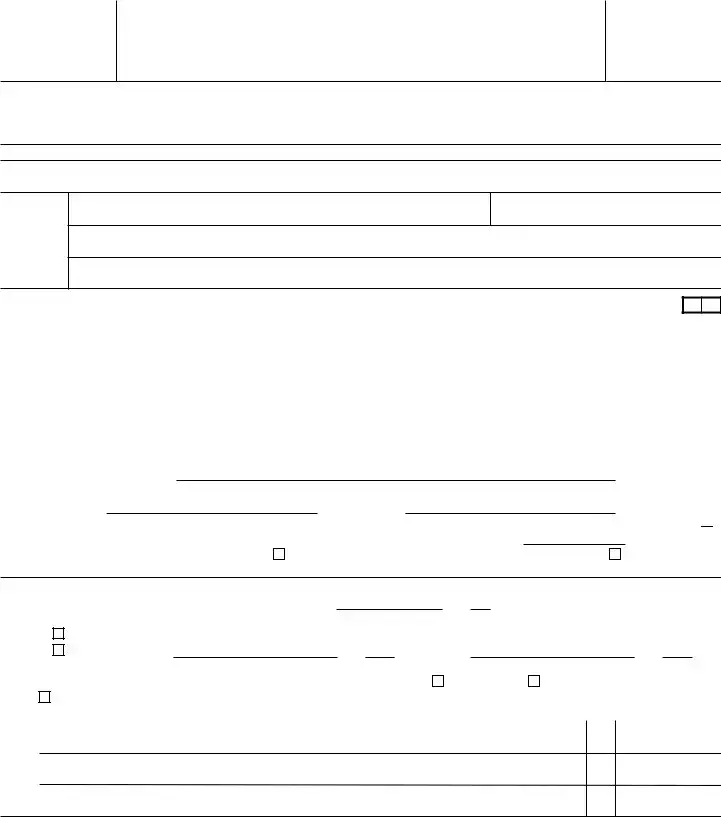General Instructions
Section references are to the Internal Revenue Code unless otherwise noted.
Future Developments
For the latest information about developments related to Form 8868 and its instructions, such as legislation enacted after they were published, go to www.irs.gov/Form8868.
What’s New
Trusts required to file Form 990-T by the 15th day of the 4th month (April 15 for calendar year taxpayers) (including Employee plans, IRAs, SEPs, SIMPLEs, Coverdell ESA, and Archer MSA) should enter Return Code 05. Trusts required to file Form 990-T by the 15th day of the 5th month (May 15 for calendar year taxpayers) should enter Return Code 06.
Reminders
Automatic revocation. If an organization has not filed the required Form 990 series for 3 consecutive years, and if the due date (or extended due date) of the third year’s filing has passed, the tax-exempt status will be revoked to the original filing date. If you have received an approved extension from the IRS for filing your return, and have not filed your return with the IRS for 3 years (including during the approved extension period), please go to Automatic Revocation of Exemption at www.irs.gov/charities-non-profits/ automatic-revocation-of-exemption for details on revocation and reinstatement for an exempt organization.
Taxpayer identification number. All users must enter their taxpayer identification number (TIN).
Return Code. A Return Code is assigned to each return type. Enter the Return Code of the form this application pertains to in the Return Code Box.
Electronic filing (e-file). Electronic filing can be used to request an extension of time to file each of the forms listed above (with the exception of Form 8870, applications for the extension of which must be sent in paper format to the address below).
|
If you are going to make an |
▲ |
! |
electronic funds withdrawal |
(direct debit) with this Form |
CAUTION |
8868, see Form 8453-TE or |
|
Form 8879-TE for payment instructions.
Purpose of Form
Form 8868 is used by an exempt organization to request an automatic
6-month extension of time to file its return.
Also, the trustee of a trust required to file Form 1041-A or Form 5227 must use Form 8868 to request an extension of time to file those returns. These instructions apply to such trusts unless the context clearly requires otherwise.
Use this form to apply for an automatic 6-month extension of time to file an organization’s return, and submit the original form to the IRS (no copies are needed).
The automatic 6-month extension will be granted if you properly complete this form, file it, and pay any balance due on line 3c by the due date for the return for which the extension applies.
|
You cannot use Form 8868 to |
▲ |
! |
extend the due date of Form |
990-N. |
CAUTION |
|
An organization will only be allowed an extension of 6 months for a return for a tax year.
When To File
File Form 8868 by the due date of the return for which you are requesting an extension.
Where To File
If you do not file electronically, send the application to:
Department of the Treasury Internal Revenue Service Center Ogden, UT 84201-0045
An application for extension of time to file Form 8870 must be sent in paper format to the address above.
Do not file for an extension of time by attaching Form 8868 to the exempt organization’s return when it is filed.
Filing Information
No blanket requests. File a separate Form 8868 for each return for which you are requesting an automatic extension of time to file. This extension will apply only to the specific return checked. It does not extend the time for filing any related returns. For example, an extension of time for filing a private foundation return will not apply to the return of certain excise taxes on charities (Form 4720).
Each Form 8868 filer who owes taxes for the year should file its own Form 8868, and pay only its share of the total tax liability due.
Exempt Organization Group Returns. A central organization may apply for an extension of time to file a group return. Enter the applicable Return Code and enter the Group Exemption Number (GEN) on the line provided. Check the applicable box to indicate whether the application applies to the whole group or part of the group. If the extension is not for all the organizations that are part of the group, you must
attach a schedule to Form 8868 showing the name, address, and taxpayer identification number of each organization that is included in this request for an extension.
Interest. Interest will be charged on any tax not paid by the regular due date of the return from the regular due date until the tax is paid. It will be charged even if the organization has been granted an extension or has shown reasonable cause for not paying on time.
Late payment penalty. Generally, a penalty of ½ of 1% of any tax not paid by the due date is charged for each month or part of a month that the tax remains unpaid. The penalty cannot exceed 25% of the amount due. The penalty will not be charged if you can show reasonable cause for not paying on time.
If you receive an extension of time to file, you will not be charged a late payment penalty if (a) the tax shown on line 3a (or the amount of tax paid by the regular due date of the return) is at least 90% of the tax shown on the return, and
(b)you pay the balance due shown on the return by the extended due date.
Late filing penalty. A penalty is charged if the return is filed after the due date (including extensions) unless you can show reasonable cause for not filing on time.
Different late filing penalties apply to information returns. See the specific form instructions for details.
Reasonable cause determinations. If you receive a notice about penalties after you file your return, send an explanation and we will determine if you meet reasonable cause criteria. Do not attach an explanation when you file your return. Explanations attached to the return at the time of filing will not be considered.
Tax Payments
General rule. Each tax-exempt organization must make all federal tax deposits (including excise and income taxes) electronically. You can use the Electronic Federal Tax Payment System (EFTPS) to make federal tax deposits. If you do not wish to use EFTPS, you can make arrangements through your tax professional, financial institution, payroll service, or other trusted third party to make deposits on your behalf.
EFTPS is a free service provided by the Department of the Treasury. If you choose to use a tax professional, financial institution, payroll service, or other third party to make federal tax deposits on your behalf, you may be charged a fee for this service.



